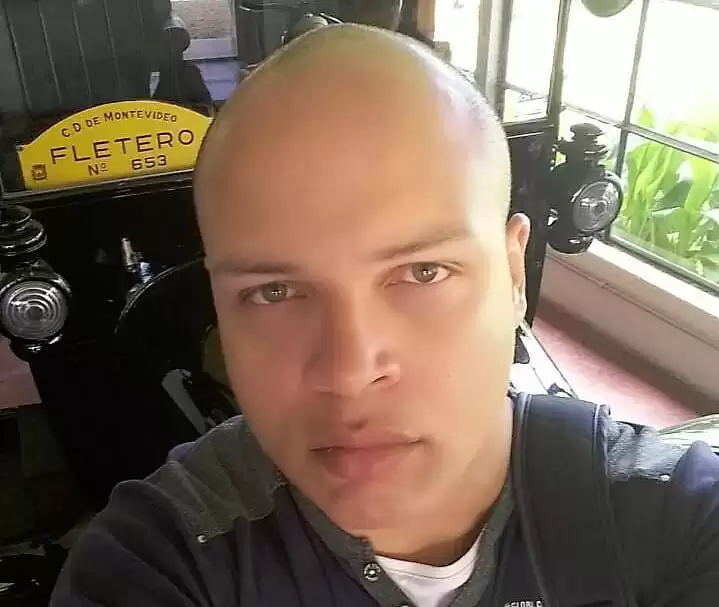ROCHA, Artur Batista de Oliveira [1]
ROCHA, Artur Batista de Oliveira. The Teaching of Music for the Visually Impaired. Multidisciplinary Scientific Journal. Edition 8. Year 02, Vol. 05. pp. 105-120, November 2017. ISSN:2448-0959
ABSTRACT
The purpose of this article is to reflect on teaching music to the visually impaired. Musical education for the visually impaired works with hearing, with musical experience from the exploration of body movement, laterality, motor coordination, rhythm and tactile stimulation; in the case of recognition of musical instruments in the correct position to hold them and play them to implement them. The musical signage in Braille is represented in the same way that the literary text is written, that is, by combining the six points of the Braille cell, generating a total of 63 characters and the empty cell, which are distributed linearly, without the possibility of add more than one Braille line to represent a musical pattern. The teaching of Braille music notation offers the autonomy and independence to read a score, not just depending on the memory or the help of other people. It is believed that in this way students will be able to effectively participate in free music courses in schools and universities, because they will have mastery of musical writing, following the themes proposed by these schools.
Keywords: Visual Deficiency, Music Education, Braille System.
1. Introduction
Education for people with disabilities or disorders and high skills presents a history structured on prejudiced and discriminatory principles. The end of the nineteenth century marked the creation of pioneering institutions based on the biological conception that prioritized medical care in detriment of the educational and distancing from living in society (JÚNIOR, 2012).
According to Mittler (2003), what was a source of shame, contempt and elimination in certain societies gained space in the culture of the beginning of the twentieth century as an assistance, but still segregated from other groups and with a tendency to pity and, to that end, have developed medical rehabilitation services and education care, some more, some less.
According to Rogalski (2010), until the 1950s, special education in Brazil had a small expression, with charitable or philanthropic entities. From the 1960s, the modality of education was officially instituted and called "education of the exceptional".
In the 1970s, Brazilian special education gained more space in the Government Plan that stimulated the creation of institutions. According to Mantoan (2002), the conduction for charitable institutions and associations perpetuated the welfareist conception, with a strong protectionist character.
In the 1980s, the world scenario was directed towards the social integration movement. The new order conceived as a process should provide adequate means in education to meet the needs of students. In Brazil, this new guideline gained momentum from the second half of the 1980s.
According to Silva (2009), until the 1980s, society used terms such as exceptional, crippled, defective, incapacitated, invalid, deaf, mute, blind. These pejorative terms were replaced by poor, after influencing the debates in the World Health Organization, which established the Decade of Persons with Disabilities.
Rogalski (2010) points out that the concept of school integration seems to have taken on the sense of simply placing people with disabilities in the same school, not necessarily in the same class, thus ratifying the welfareist and protectionist character. segregation in relationships and attitudes.
According to Mantoan (1993), reinforced in the 1990s, the school integration movement was related to the concept of promoting school access for people in unfavorable conditions, that is, children with disabilities, disorders and high skills adapt themselves in the school spaces , divide the same spaces and seek adaptation to achieve overcoming, as well as the maximum possible of normality. Thus, the proposal to conquer only school access has been reduced and school integration has assumed another guideline. In line with the integration movement in schools in the 1990s, reference expressions and terminology were changed for the disabled and students with special educational needs.
Currently, with the concept of inclusive education, the terminology used and recommended by the Law of Guidelines and Bases is a person with a disability. Other references recommended by pro-inclusive associations emphasize some expressions to differentiate the identity of the deaf community and people with hearing impairment, as well as blind people and those with low vision. It should be noted that the pedagogical conception that subsidizes a large part of Musical Education has, in general, an exclusionary character (BRAZIL, 2013).
The teaching of music is made from a model in which the teacher transmits a set of theoretical concepts unrelated to musical making, and in which the technique is often overvalued, to the detriment of the students' potentialities. Generally, knowledge is taught in a hierarchical way and is framed in disciplines, so that students have difficulty establishing interrelations between different knowledge. To make this idea concrete, one can take, for example, the contents learned in the areas of History of music and harmony. In history, the student makes contact with the characteristics of a certain period, and in Harmony he has the opportunity to deepen the harmonic aspects contained in the pieces produced at that time. However, the separation or fragmentation of this knowledge favors the student not being able to integrate them into a coherent whole (SILVA, 2009).
Musical education for the visually impaired works with hearing, with musical experience from the exploration of body movement, laterality, motor coordination, rhythm and tactile stimulation; in the case of recognition of musical instruments in the correct position to hold them and play them to implement them. The teacher accompanies his student, teaches the hands in the correct position to play an instrument and, for example, get a certain sound. Above all, you need to use your innate perception and stimulate others through this musical experience. Making music the visually impaired participates more actively the environment in which it is inserted, gaining self-confidence, independence and expansion of its cultural universe (MCCANN, 2009).
According to Giesteira (2009) musical educators specializing in education for the visually impaired throughout the world contemplate Braille musicography as an effective way of producing a more complete and efficient musical learning for the visually impaired. Even so, in Brazil, it has not yet been properly used. Few Brazilian music educators make use of it, which greatly hampers the learning of musical reading by these students (SILVA, 2010).
2. Methodology
The present work was characterized by being bibliographical, developed from materials elaborated and published by numerous authors chosen to help in the elaboration of this work to start from the question that aimed to elicit reflections on the theme. The bibliographic search was carried out by the following databases: Portal of Periodicals of the Coordination of Improvement of Higher Level Personnel – CAPES (http://www.periodicos.capes.gov.br/), Banco de Teses e Dissertações da Universidade Estadual of Campinas – UNICAMP (http://www.bibliotecadigital.unicamp.br/document/list.php?tid=7), Scientific Electronic Library – SCIELO (http://www.scielo.org/php/index.php) and the MusiBraille Project database (http://intervox.nce.ufrj.br/musibraille/textos.htm.). In order to find the answers and solutions to the problems in the process of inclusion of music in the teaching of the visually impaired.
"Scientific activity is an attribute of all those who really want to devote themselves to the activity of discovering new knowledge, to seek new relationships where they seem impossible, to unveil thoughts and theories and to put them at the service of what one intends to understand" ( DEMO, 1987, p.39).
Thus, it is of great relevance to obtain a theoretical and methodological reading so that the chosen theme can be contextualized, causing the teacher / researcher to learn to contextualize his research model in a theoretical model of great breadth and to support the analyzes acquired through of the research.
2.1 Teaching music and visual impairment
Ray (2004) studied the "absolute ear" phenomenon among people with visual impairment and concluded that among blind individuals there is a higher prevalence of people with absolute hearing compared to individuals with vision impairment. However, Figueira (2002) points out that, throughout history, we can find countless examples of visually impaired people who have dedicated themselves to music and who have gained recognition in this area.
Oliveira (1995) uses the memory of four blind musicians and thus reconstructs his life stories in the light of Deleuze's thought and uses the four signs proposed by this philosopher: worldly, affective, loving and artistic signs. In his analysis of the collected testimonies, Oliveira (1995) considers that music appears as a guiding axis of the subjects' life reports, and thus affirms the role of this art in the construction of the identity of these individuals.
According to Bonilha (2010) there are institutions whose approach regarding the insertion of music for the visually impaired into their programs is more comprehensive. As an example, the Benjamin Constant Institute (RJ) can be mentioned, in which there are courses aimed at the improvement of musical aptitudes in specific modalities, such as: string instrument, keyboard, wind instrument, choral singing, etc.
2.2 The Braille system
French educator and inventor of the tactile reading and writing system for the blind who carries his name, based on a representation method that uses six dots of cells in relief. The Braille method is currently the universally promulgated reading and writing system in the educational programs of the blind. Braille applied his novel method to the alphabet, numbers and musical notation (CERQUEIRA, 2009).
Braille became a teacher and won the admiration of all his students. Unfortunately he passed away at the age of 43, taking with him the thought that his revolutionary invention would probably disappear with him, but this did not happen because countless people knew his method. In 1860, the Braille system was introduced at the school for the blind in Saint Louis in the United States (LEMOS et al, 1999).
In 1868 a group of four researchers, led by Dr. Thomas Armitage, founded a society in the United Kingdom to promote the improvement and dissemination of literature for the visually impaired. This small group of researchers grew to become the National Institute for the Blind, the largest publisher of Braille texts in Europe and the largest British organization for the visually impaired. In the twentieth century, the Braille method had been deployed in almost every country in the world (CERQUEIRA, 2009).
The Braille system consists of 63 characters, resulting from the combination of 6 points, arranged in two vertical columns, and numbered from top to bottom and from left to right. The matrix set formed by the total of points gives rise to the fundamental signal, from which the other characters are derived. The space occupied by each character is called the Braille cell. Signals that occupy only one cell are called Simple Signals, while those that occupy a larger number of cells are called composite signals (BONILHA, 2010).
The character set is conventionally presented in a sequence called Braille Order, and these characters are distributed in 7 series, logically constituted. Figure 1 shows the Braille order, where each series consists of a line of characters (MOSQUERA, 2010).
The first series consists of the upper signals, which consist only of points 1,2,4 and 5. The following 4 series are derived from these signals. Thus, the second series consists of the upper signs plus point 3. In the third, these signs are added to points 3 and 6. And, in the Fourth, it is added to them the point 6 (SILVA, 2010).
According to Silva (2010) the fifth series is formed by the lower signals, (constituted by points 2, 3, 5 and 6), and formally reproduces the first. The sixth series contains signs formed by points 3, 4, 5 and 6. Finally, the seventh series consists of signs of the right column, (formed by points 4, 5 and 6).
As for the application of this system, the characters become polyvalent, so that the same signs are used to represent literal, mathematical, chemical, computer and musical symbols (MOSQUERA, 2010).
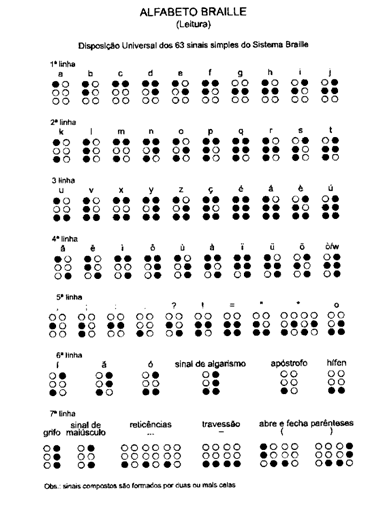
2.3 Musicography in Braille
The musical signage in Braille is represented in the same way that the literary text is written, that is, by combining the six points of the Braille cell, generating a total of 63 characters and the empty cell, which are distributed linearly, without the possibility of add more than one Braille line to represent a musical pattern. The top four points of the Braille cell represent the height of the note and the two lower points represent the duration. Due to the limited number of combinations, musical signage in Braille is produced by the combination of one or more Braille characters. Generally, a Braille character can have more than one meaning, the interpretation of certain characters depends on the context in which it is inserted. However, musicography has tools to reduce punctuation length and facilitate its reading (Bortolazzi et al., 2008). One of the drawbacks of musical writing in Braille is the fact that we can not read and play simultaneously. The student has to memorize a musical passage before playing it, this requires the reader a great mental effort to memorize all the information in a short time. Another particular feature of Braille music writing, according to Nicotra and Quatraro (2008), is related to the full view of the count, a sighted musician can read a score using different criteria, such as ignoring certain symbols, reading only notes, reading a part of a system, etc. In reading Braille music, this is not possible, because reading occurs sequentially and linearly. The learning of Braille musicography requires a greater study of the musical elements, due to the numerous rules necessary to develop the first stages of musical formation. "This system requires blind music students to have certain theoretical musical knowledge in advance with regard to students without visual impairment" (Fernández-Álvarez; Aller-Pérez, 1999, p.35)
The Braille score proposes a differentiated structuring to represent the information contained in the musical notes (figures 2). "Braille music is like a shorthand that needs to be deciphered, little by little as a puzzle" (Nicotra and Quatraro, 2008, p.10). Bertevelli (2010) points out that the teaching of music for people with visual impairment is little different from the teaching for sighted people, the only difference is given in relation to musical writing, which is produced through the Braille system (figure 3). A method of musical teaching literally transcribed for the Braille system, does not present a logical order of the learning of the musical theory in Braille. Bonilha (2009) points out that the basic differences between the two codes make it necessary for the means of learning to be different. Dedican (2007) states that in seer teaching methods, in the early stages of learning, the concepts of interval are hardly introduced, which is fundamental in writing the octave indications in the Braille system. The characteristics of musical writing in Braille are reflected in the instrumental learning and in the way the didactic material is organized (GIESTEIRA, 2011).
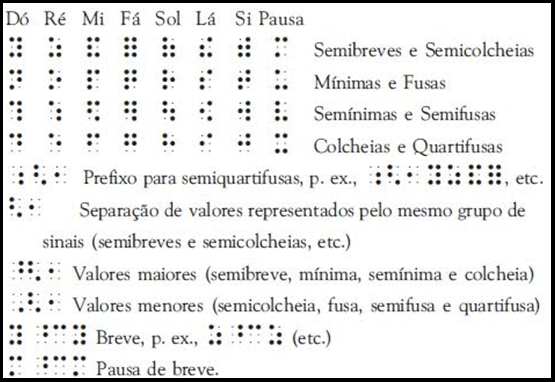
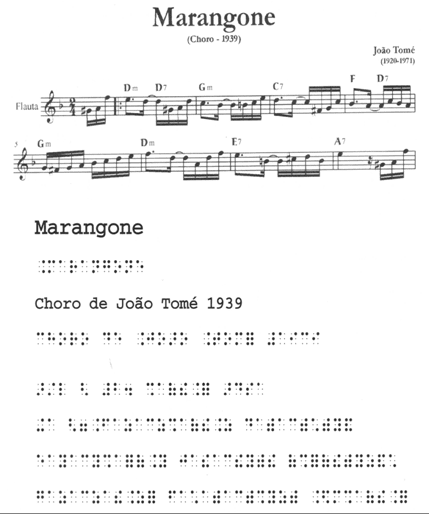
2.4 MusiBraille Software
The Brazilian software MusiBraille (figure 4) was developed by Dolores Tomé, José Antonio Borges and Moacyr de Paula through the culture incentive law sponsored by Petrobrás in 2009. It is free software, which can be downloaded from the site: http://intervox.nce.ufrj.br/musibraille/textos.htm. (MUSIBRAILLE, 2017)
According to MusiBraille (2017) MusiBraile is intended to create favorable conditions for musical learning so that a visually impaired student has the same access condition to learning tools as a sighted person.
For MusiBraille (2017) MusiBraille musicography and operation courses are applied regionally. The project included the five regions of Brazil, with the cities chosen: Brasilia, Recife, Belém, Rio de Janeiro and Porto Alegre. During the training a kit is distributed to each student. Each kit consists of:
- A CD-ROM with music-transcription software for Braille.
- Tutorials on film about Braille musicography and about the Musibraille program.
- Software instruction manual.
- A copy of the book "Introduction to Musicography Braille", by Dolores Tomé.
- A copy of the "Braille Musical Theory" exercise book.
- Useful texts.
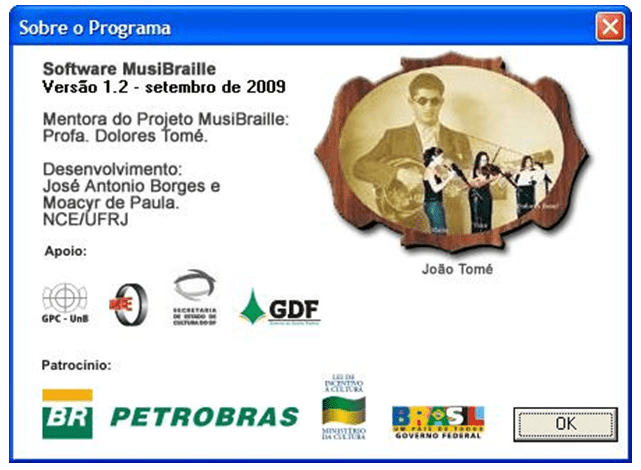
According to Borges et al. (2017) the MusiBraille software allows you to perform the following operations:
- Specify various details about the current song: name, composer, pitch, measure, tempo, and instrument.
- While typing, you can hear the musical notes created or even the name of the figures created in the Braille score.
- Cut and paste musical strings.
- Utilities such as ink typing, dictionary and dictation training.
- Play the score: During this display, the notes being played are indicated in the braille score. In the area where the score is displayed in ink, the braille line containing the note being played is also generated synchronously (figure 5).
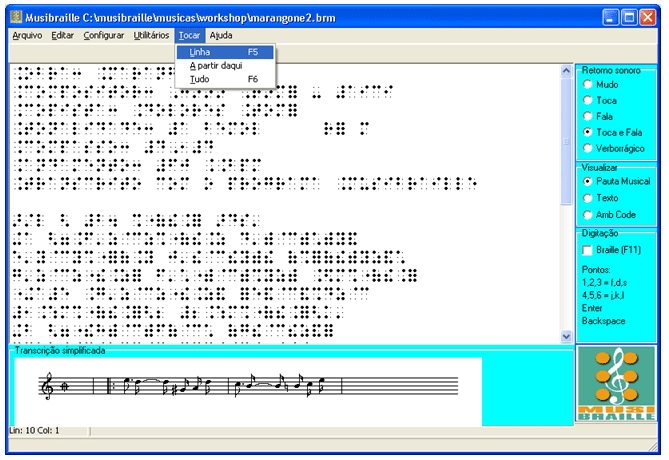
Final considerations
The musical education of the visually impaired does not differ from the seer, it encompasses auditory perception and musical practice. Some adaptations are needed, such as the methodology used, teacher training and the production of transcription specific and accessible material of scores and music books, which are resources for musical education.
Allied to this process, the teaching of Braille musicography with its rules and combinations, has facilitated the possibility of knowledge and use of a system, still functional nowadays, that we try to rescue. The knowledge of this system is necessary for the production of the specific and accessible material, with the transcription of music scores and books, as well as the formation of the transcriber and the musical educator, who today, more than ever, must learn the forms of communication musical, its forms of expression and registration of the differentiated musical code, as a resource of the musical education of visually impaired people and their possible access to all music.
The teaching of Braille music notation offers the autonomy and independence to read a score, not just depending on the memory or the help of other people. It is believed that in this way students will be able to effectively participate in free music courses in schools and universities, because they will have mastery of musical writing, following the themes proposed by these schools.
This is why more investment is needed if two factors in this process are to receive due attention. The first is the production of specific and accessible material, with the transcription of scores and music books so that more students have contact with this practice. The second factor is the specific training of the music educator, who will be able to promote access to music, guaranteeing the acquisition of a necessary skill for the musician, professional or not, but which is a right for all.
references
BERTEVELLI, I.C. D. The musical education of people with visual impairment and musicology Braille: from musicalization to reading and writing the score in Braille. In: Meeting of the Argentine Society for the Cognitive Sciences of Music, 9., 2010, Buenos Aires. Anais … Buenos Aires: SACCoM, 2010. P. 58-64.
BONILHA, F.G .; CARRASCO, C.R. Musical reading at the fingertips: reflections on the teaching and learning of Braille musicography. In: SYMPOSIUM OF COGNITION AND MUSICAL ARTS, 5., 2009, Campinas. Actas … Campinas: UNICAMP, 2009. P. 85-9
BONILHA, F. G. From touch to sound: The teaching of Braille musicography as a path to inclusive music education. 2010 280f. Thesis (Doctorate in Music) – Institute of Arts, State University of Campinas, São Paulo. 2010
BORGES, A .; PAULA, M .; TOMÉ, D. Musibraille: Operation manual version – 1.4. Available at: <http://www.musibraille.com.br/textos/>. Accessed on: 30 jun. 2017.
BORTOLAZZI, E .; BAPTISTE-JESSEL, N .; BERTONI, G .. BMML: A Mark-Up Language for Braille Music. In: International Conference on computers helping people with special needs ,, 11., 2008, Linz, Austria. Anais … Linz: Springer-Verlag, 2008. P. 310-317.
BRAZIL. Law No. 12,796, of April 4, 2013. It amends Law No. 9,394 of December 20, 1996, which establishes the guidelines and bases of national education, to provide for the training of education professionals and to take other measures. Official Gazette of the Federative Republic of Brazil. Brasília, April 4 2013.
CERQUEIRA, J. B. The Legacy of Louis Braille. Revista Benjamin Constant, Rio de Janeiro, n. esp., 2009.
DEDICON. Contrapunctus: Preservation and unification of new and existing Braille music digital sources for a new access methodology. Sixth. (Report nº IST 2005-034226). Sixth Framework Program. Lombardia: Information society technologies, 2007.
DEMO, P. Introduction to the methodology of science. 2nd ed. São Paulo: Atlas, 1987.
FIGUEIRA, E. The presence of visually impaired people in the arts. Saci Network, 2002. Available at: <http://www.saci.org.br/index.php?modulo=akemi& parametro = 4574>. Accessed on: 02 jun. 2017.
GIESTEIRA, A.C. Musical writing for the blind: Louis Braille and music. Music and education magazine, v.85, n1, p. 48-62, 2011.
JÚNIOR, E. M. 50 years of Special Education Policies in Brazil: movements, advances and setbacks. 2012. Available at <http://www.ucs.br/etc/conferencias/index.php/anpedsul/9anpedsul/paper/viewFile/1464/670>. Accessed on 02 Jul. 2017.
LEMOS, E.R; Venturini, J.L .; Cerqueira, J.B .; ROSSI, T. F. O. Louis Braille: his life and his system. São Paulo: Dorina Nowill Foundation for the Blind, 1999.
MANTOAN, M. T. E. Integration x Inclusion: School (of quality) for all. 1993. Available at: <http://styx.nied.unicamp.br/todosnos/acessibilidade/ texts / magazines / Integ School Inclusion For All. rtf / view>. Accessed on: 02 Jul. 2017.
MCCANN, W.R. Braille, the man and his musical code. Journal of the Educator, v21, n.2, p.27-30, 2009.
MITTLER, P. Inclusive Education: Social Contexts. São Paulo: Artmed, 2003.
MUSIBRAILLE. Available At: <http://intervox.nce.ufrj.br/musibraille/textos.htm.> Accessed on: 24 jun. 2017.
NICOTRA, G .; QUATRARO, A. Contrapunctus Project: A New Computer Solution for Braille Music Fruition. In: MIESENBERGER, K; KLAUS, J .; ZAGLER, W .; KARSHMER, A; (Eds.), Computers Helping People with Special Needs. Austria: Springer Berlin Heidelberg, 2008. P. 303-309.
ROGALSKI, S.M. History of the emergence of Special Education. Journal of the Institute of Educational Development of the Upper Uruguay – IDEAU, v. 5, n. 12, p. 2-12, 2010.
SILVA, A. M. Special education and school inclusion: history and fundamentals. Curitiba: Ibpex, 2010.
SILVA, M. I. Why the terminology "people with disabilities" ?. Accessibility and Inclusion Nucleus, Universidade Federal Fluminense, 2009. Available at: <http://www.prograd.uff.br/sensibiliza/por-que-terminologia-pessoas-com deficiencia>. Accessed on: 02 Jul. 2017.
[1] Graduated in pedagogy and specialist in: literacy and literacy and institutional psychopedagogy.
